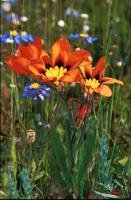Home
Study Sites
Research
Results
Publications
Links
Contacts
What are Ecosystem Sevices?
Ecosystems Provide Goods and Services
We are all familiar with many of the "goods" that natural ecosystems provide, such as food, fodder, fuelwood, timber and medicines. It is relatively easy to calculate what these natural resources contribute to the economy. However, most of us overlook the large number of life-support "services" that natural ecosystems freely supply. They are more difficult to see or to quantify, but it is these ecosystem services that enable us to survive on Planet Earth.
Pure Water - A Free Ecosystem Service
Nature's cycles and processes, including interactions between plants, animals and micro-organisms, provide the ecosystem services. Water purification is one example. The climate drives the water cycle, which continuously purifies water through evaporation, condensation and precipitation. A natural river system also offers water purification services. Riparian vegetation reduces rates of soil erosion and reed beds in wetlands slow the rate of flow of the river, allowing silt to settle out.
When natural systems break down it is costly, if not impossible, to provide these services artificially. Furthermore, poorly functioning ecosystems cause problems that are difficult and therefore expensive to address. For example, destruction of the natural vegetation along rivers causes erosion of river banks. This results in muddy water, which is expensive to purify and in which few plants or animals can survive. Downstream, dams become silted up, reducing water storage capacity.
Ecosystem Services are Running Down
Natural ecosystems are fairly resilient. However all over the world, large-scale destruction of natural habitats, plants and animals is undermining the very systems and processes upon which life depends.
In the last fifty years we have witnessed:
- Huge losses of biodiversity, through over-harvesting and habitat destruction.
- Disruption of nutrient cycles, through burning of fossil fuels and excessive use of nitrogen fertilisers.
- Global climate change, resulting from increasing levels of greenhouse gases in the atmosphere.
- Erosion and loss of fertile topsoil due to insensitive farming and development.
- Pollution of air, water and soil, affecting the health of people and ecosystems.
What has been responsible for these unprecedented levels of environmental exploitation and destruction? A rapidly growing human population, higher levels of consumption per capita and the insensitive development and use of technology have all played a part.
A Role for Farmers
Farmers manage about 80% of South Africa's land surface area. Through sustainable land management, farmers can make a significant contribution to the maintenance and restoration of ecosystem processes and services.
Ecological Restoration
Ecological restoration involves the rehabilitation of soil, water and natural vegetation to enhance natural ecological processes. Well functioning ecosystems automatically provide the ecosystem services listed earlier. Because the network of nature reserves in South Africa is inadequate, the country must also rely on its farmers to manage the land in a sustainable manner. Farmers can guarantee the sustainability of ecosystem services by maintaining and restoring natural habitats and the diversity of indigenous plants and animals on their land.
Local Research
Conservation farming aims to maintain and restore functioning ecosystems on farms, while at the same time sustaining high levels of agricultural production. The National Botanical Institute's Conservation Farming Project is investigating ecologically sensitive farming practices in four regions of South Africa to find out:
- The impacts of different types of land use on the functioning of ecosystems and on agricultural productivity.
- The benefits of conservation farming compared to more traditional farming methods.
- Whether farmers, farm workers, local communities and consumers in general benefit from the goods and services that these natural areas provide.
 Initial research indicates that conservation farming provides many benefits, such as a diverse diet for livestock, shelter for livestock (particularly during lambing season), firewood, honey, and horticultural and medicinal plants. As interest in the environment grows, many farmers are relying on ecotourism to supplement their income. Game viewing, birding and flower tours are particularly popular and all rely on well-managed natural ecosystems.
Initial research indicates that conservation farming provides many benefits, such as a diverse diet for livestock, shelter for livestock (particularly during lambing season), firewood, honey, and horticultural and medicinal plants. As interest in the environment grows, many farmers are relying on ecotourism to supplement their income. Game viewing, birding and flower tours are particularly popular and all rely on well-managed natural ecosystems.
By investigating land use practices in different parts of South Africa the Conservation Farming Project will determine which methods are the most productive and sustainable. The project will also develop models to estimate the economic value of ecological services provided under these different conditions.
Counting the Cost
Ecological economics aims to quantify the value of ecosystem goods and services to the economy. In the past we generally took for granted both the natural resources and free services that well functioning ecosystems provided. Development and environmental degradation are now threatening the sustainability of ecosystems. We need to put a monetary value to ecosystem services like pollination, natural pest control and the mitigation of droughts and floods, in order to convince decision-makers and developers that conservation makes good economic sense. By quantifying the value of natural goods and services, ecological economics may help to show more clearly the long-term costs of unsustainable development.
As yet very few studies have estimated the nature, value and extent of natural ecosystem services - or the costs to the economy should these services fail. We may, however, assume that the value of these services will be high. The Conservation Farming Project aims to estimate just how great the value of these services are to the agricultural sector in four different natural regions of South Africa.
Fact Sheet
Click here to view our fact sheet on ecosystem services.
These pages use CSS style sheets.
If you experience problems viewing them, please turn style sheet support in your browser off, or download a new browser.